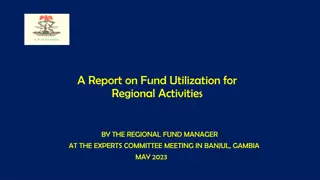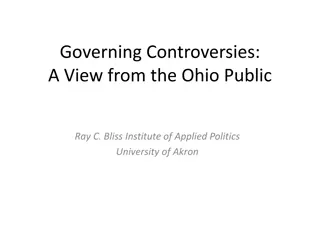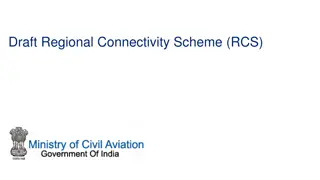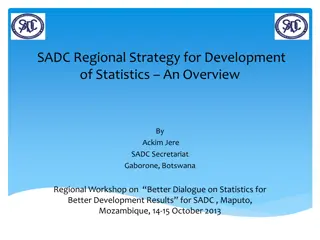Regional Training Workshop on Results-Based Management and Legislative Performance
This presentation covers the definition, purpose, and functions of indicators in the context of measuring progress towards goals and objectives. It discusses the importance of indicators in identifying trends, predicting problems, and evaluating performance. Various types of indicators and their roles in decision-making and measuring progress are highlighted.
Download Presentation

Please find below an Image/Link to download the presentation.
The content on the website is provided AS IS for your information and personal use only. It may not be sold, licensed, or shared on other websites without obtaining consent from the author.If you encounter any issues during the download, it is possible that the publisher has removed the file from their server.
You are allowed to download the files provided on this website for personal or commercial use, subject to the condition that they are used lawfully. All files are the property of their respective owners.
The content on the website is provided AS IS for your information and personal use only. It may not be sold, licensed, or shared on other websites without obtaining consent from the author.
E N D
Presentation Transcript
NILS-CAP REGIONAL TRAINING WORKSHOP ON RESULTS-BASED MANAGEMENT AND LEGISLATIVE PERFORMANCE, 27-31 July 2015, Accra, Ghana Indicators-General Concepts and Parliament Specific Indicators. Prepared by Issifu Lampo Senior Governance Advisor, ACEPA
OUTLINE OF PRESENTATION Definition of indicators Purpose and functions of indicators Characteristics of good indicators Developing outcome indicators Key indicators for Parliament
Definition of indicators Litman (2009) defines indicators as variables that we use to measure and evaluate progress towards goals and objectives. Indicators can help identify trends, predict problems, assess options, set performance targets, and evaluate a particular jurisdiction or organization.
Definition of indicators (2) Litman noted equivalent to senses-they determine how things are perceived and what receives attention. An indicator is a variable that provides accurate and reliable evidence about the achievement of a specific result. that, indicators are
Defining indicators (3) In short, indicators are important tools for making decisions and measuring progress. What gets measured gets done If you don t measure results, you can t tell success from failure .
Purpose and functions of indicators Planning activities rely on indicators for providing guidance. However, the purpose of planning is not only to develop goals but to accomplish them. One way to know whether you have accomplished a goal is to measure performance.
Purpose and functions of indicators (2) According to Gudmundsson (2007) an indicator does not only measure performance but also performs a number of important functions. Indicators have communication function: they tell why such a thing is important. They also perform the informative function, how we doing things. Indicator also have the diagnostic function, telling what is wrong.
Purpose and functions of indicators(3) Additionally, indicators have the action function, telling what to do. According to the Division of Economic and Social Affairs of the United Nations (2007), indicators can help make better decisions and more effective actions by simplifying,
Purpose and Functions of Indicators (4) clarifying, and making aggregated information available to policy makers . They enable us to incorporated physical and social science knowledge into decision- making, to measure and calibrate progress towards sustainable development goals.
Purpose and functions of indicators (5) Indicators provide early warning to prevent economic, social and environmental setbacks. Indicators are also useful tools to communicate ideas, thoughts and values.
Criteria for Selecting Good Performance Indicators Performance indicators should be: SMART Specific,Measurable,Attributable, Realistic,Targeted
Specific: Measure as closely as possible what is intended to measure Outcome Outcome Parent insure that clinics Children get treatment for malaria Indicator Indicator Increased utilization of Increased malaria drugs Which indicator is more specific? use of
Measurable:Clear and unambiguous about what is measured 1. % of health centres without stock out of drugs x, y, and z for more than a week 2. % of health centres with availability of drugs Which indicator is measurable?
Attributable:attributable to the project s /program s efforts 1. Life expectancy 2. % of children fully immunized at 1 year. Which indicator is attributable?
Realistic: Realistic: data obtained at reasonable data obtained at reasonable cost with enough frequency cost with enough frequency 1. HIV population 2. HIV prevalence among 15-24 year old pregnant women Which indicator is more realistic? prevalence among the total
Targeted: Targeted: it should be specific about it should be specific about the targeted population/area the targeted population/area 1.Percent increase in employment 2. Percent increase in employment of graduate of technical training centre x in the first year after completion of training. Which indicator is targeted?
Baseline and Targets Baseline: Value of the indicator at the beginning of the program. Used as a point of comparison when measuring programs toward a specific result. Target Value: The intended value of the indicator at the end of a specified point in time against which actual results will be measured.
Proxy Indicators(Why are they necessary?) Only use indirect measures (proxies) when data for direct indicators are not available or feasible to collect at regular intervals Example Number of tin roofs or televisions as a proxy measure of increased household income.
Developing A Set of Outcome indicators for a Policy Area: Outcomes 1. Nation s children have improved access to pre- school programs 2. Primary school learning outcomes for children are improved Indicators 1. % of eligible urban children enrolled in pre- school education Baseline Targets 2. % of Grade 6 students scoring 70% or better on standardized math and science text
Example of Program Development Objective (PDO) : Increase use of health facilities PDO Outcomes Outcome Indicators % of under 5 years covered by DPT immunization % of health deliveries carried out in public health facilities Intermediate Indicators % of facilities without 7- day stock outs of essential drugs(list of essential drugs defined) Increased coverage of clinics providing immunization Improved quality of doctors/nurses Intermediate Outcomes Sustained availability of drugs
Checklist for Assessing Proposed Indicators Is the indicator: As direct as possible a reflection of the outcome itself? Sufficiently precise to ensure objective measurement ? Calling for the most practical, cost-effective collection of data? Sensitive to change in the outcome, but relatively un affected by other changes Disaggregated as needed when reporting on the outcome? 1 2 3 4 5
Assignment Select Key Performance Indicators for the following outcomes #1. Improve delivery of health care to citizens living in rural areas #2. Improve quality of agriculture export products. #3. Safe urban Communities
Key indicators for Parliament Background Parliamentary development is a key stone of support to democratic development. Strong parliaments help ensure democratic accountability and responsiveness with a functional system of division of power between the executive, legislature and judiciary
Key indicators for Parliament(2) Democratic development projects (especially parliamentary development projects) are almost always small scale, and it difficult to measure their impact separately from other national and international factors affecting a country (Bermeo, 2010)
Key indicators for Parliament(5) The key themes in parliamentary development are organized into six areas: Within each of these areas, three key outcomes are identified, along with indicative activities, outcome indicators (both quantitative and qualitative). The six thematic areas are as follows: 1.Legislation 2.Oversight.3.Budget. 4.Representation 5.Administration.6.Institution Building
Key indicators for Parliament(6) The following capacity enhancement are critical to legislative strengthening: 1. Staff and MP capacity to analyze legislation 2. Technical support availability to draft and amend legislation 3. Enhanced understanding of the International legal Framework and National legislation amended to comply with international norms
Developing indicators from an Outcome statement. Outcome Indicative activities 1. Staff an MPs capacity legislation enhanced staff and MPs -Budget made available to legislative committees for obtaining expert legislative analysis -Academic and other CSO experts engaged to provide advice on legislative proposals -Targeted twinning/exchanges of staff and MPs with legislatively effective parliaments. Outcome Indicator Measurable: -Number of amendments proposed/adopted prior to and after support provided -Number of analytical reports on legislative proposals provided by staff to committees -Number of external legislative analyses commissioned and delivered Qualitative Improved quality of legislative analysis and amendments presented by legislature -Training to legislative committee staff -Training to party caucus
Developing indicators from an Outcome statement. Outcome Indicative activities 2. Technical support available to draft and amend legislation dedicated team and/or defined staff competencies in legislative drafting Outcome Indicators Measurable: -Dedicated legislative drafting support team put in place and incorporated as part of organogram and parliamentary administration pay roll -Number of pieces of legislation and amendments drafted/proposed/adopted prior to and after support provided -Number of pieces of legislation and amendments drafted by members of different party caucuses Qualitative Improved quality of legislative analysis and amendments presented by the legislature Support provided in establishing and
Developing indicators from an Outcome statement. Outcome Indicative activities Outcome Indicators 3. Enhanced understanding of the international legal framework and its application to national legislation -support for preparation of baseline study of international treaty and convention obligation -Support for legislative committee studies of international treaty, convention and international law obligations in specific areas-e.g. women, human right, trade, law, etc. -support to review of national legislation to assure it compliance and alignment with international legislation Measurable: Evidence of legislative analysis of compliance with international law generally
Sample of Outcome Statements Representation Representation Representation Representation Timely provision of information to the Public on the budget Promoting Citizens knowledge and understanding of the role of MPs in the Budget process Relations betn Parl and CSOs and other related institutions Legislation is open to citizens and the media The legislation has a non- partisan media relations facility Mechanism to promote public understanding of the work of the legislature
Sample of Outcome Statements Financial Function (Budget Financial Function (Budget Review) Review) Legislative Function Legislative Function Period for the Review of the Budget by the Legislature Existence of and Appropriation/Budget Committee Public Hearing on the Budget Process for Citizens Participation in the Budget process Law making including the Appropriates Act Power to amend the Appropriations Bill Opportunities for Public input into the legislative process Mechanism to track legislation
Sample of Outcome Statements Financial Function (Budget Financial Function (Budget Review) Review) Budget Act and Budget Budget Act and Budget Office Office Existence of a Budget Office Resourcing the Budget Office Access to information from Central Government and the Private sector Consideration of Estimates for Defense and Intelligence services by the Legislature Authority to Amend Budget presented by the Executive Power to send back proposed Budget for Review Amendments on Spending and Revenue proposals
Sample of Outcome Statements Oversight Function Oversight Function Existence of Oversight Committees Investigative Powers of Oversight Committees Oversight of Spending by State Enterprises Mechanisms for Oversight Committees to obtain information from the Executive Oversight Function Oversight Function Power of Oversight Committees to follow up on recommendations Access to resources by Oversight Committees Opportunity for Minority/Opposition Parties
Sample of Outcome Statements Public Accounts Committee Existence of a Public Accounts Committee (PAC) Chair of PAC Rights and Powers of the PAC Openness of the PAC Recommendations of the PAC Institutional Capacity of the Institution of Parliament Power of the legislature to determine its own budget Logistics available to the legislature Resources for MPs Constituency Development and activities Mechanism for receiving and coordinating Technical assistance Research and other support system
Assignment Below are three Outcome statements on Parliamentary Oversight on the left side of the table below. Develop indicative activities and outcome indicators using the outcome statements Outcome Statements Indicative activities Outcome Indicators 1. Parliament consistently and efficiently uses the available range of oversight tools 2. Improved dialogue and collaboration with CSO on policy oversight issues 3. Enhanced expert capacity of legislative committee staff to provide expert support
2. Budget Strengthening 2. Budget Strengthening Outcome Statements Indicative activities Outcome Indicators 1.Development of a core of recognized budgetary expertise within parliament 2. Support improved audit processes by strengthening interaction between parliament and supreme audit institution 3. Increased involvement of Parliament in the budget development process, animating involvement of CSOs and the population in the budget
3. Strengthening Representation Outcome statements Indicative Activities Indicative Outcome 1. Enhanced public awareness of parliamentary activities and policy debates 2. Improved awareness and responsiveness of parliamentarians to priority concerns of constituents 3. Enhanced role of parliamentarians as community leaders in preventing and mitigating conflict
Administrative Strengthening Outcome Statements Indicative Activities Outcome Indicators 1. Establishment and institutionalization of a professional parliamentary public service 2. Effective internal financial management 3. Functional documentation and information management systems























